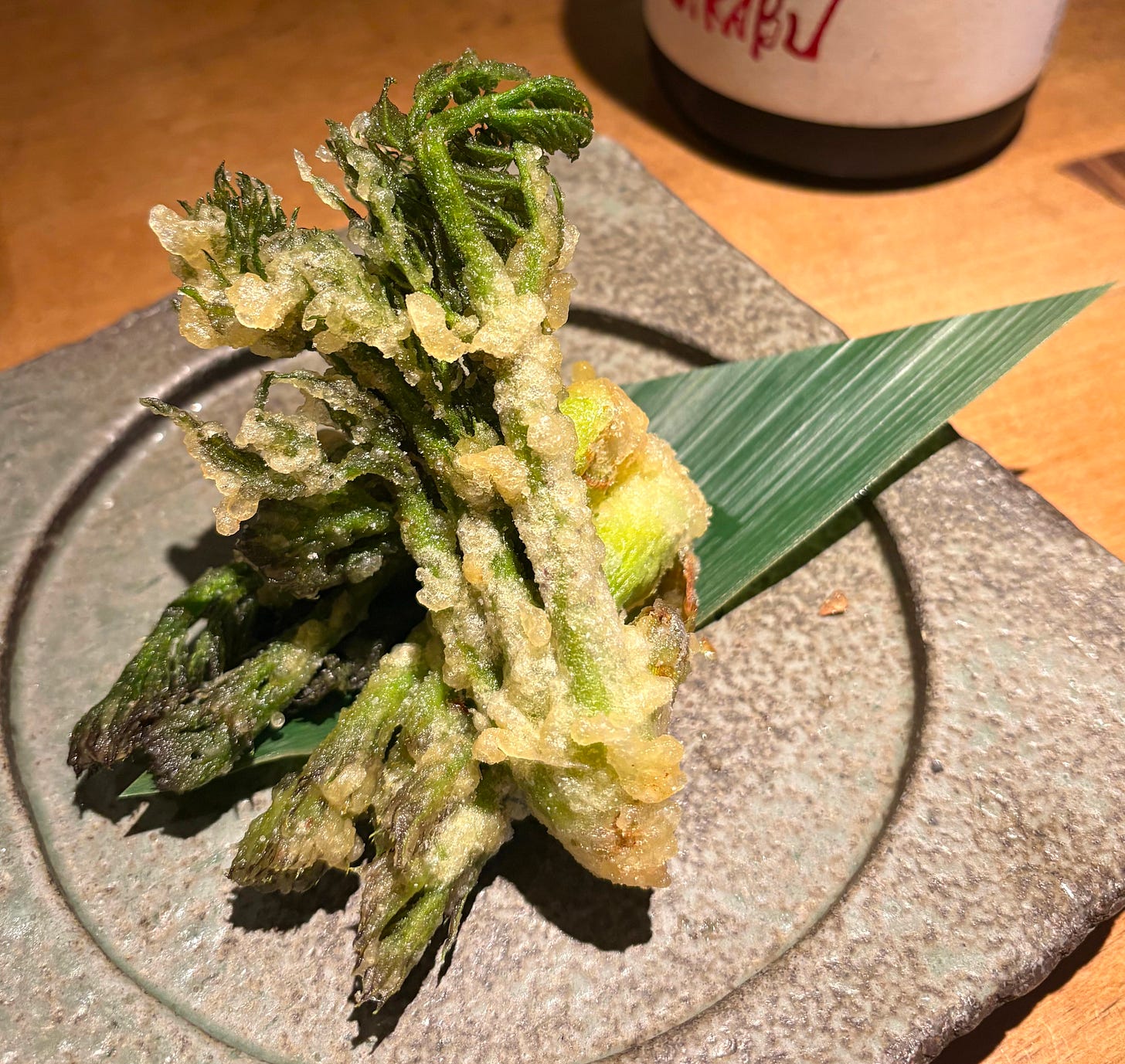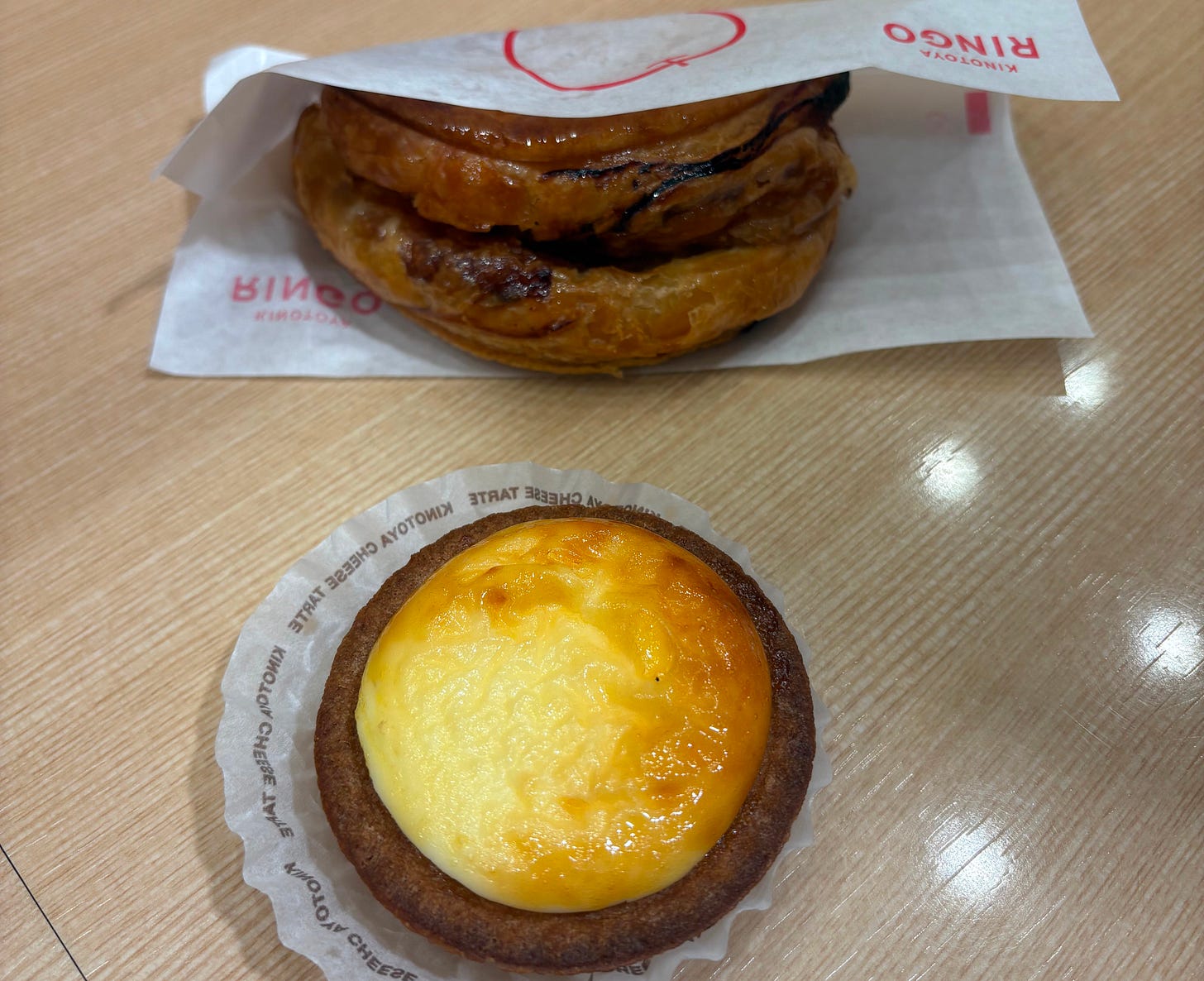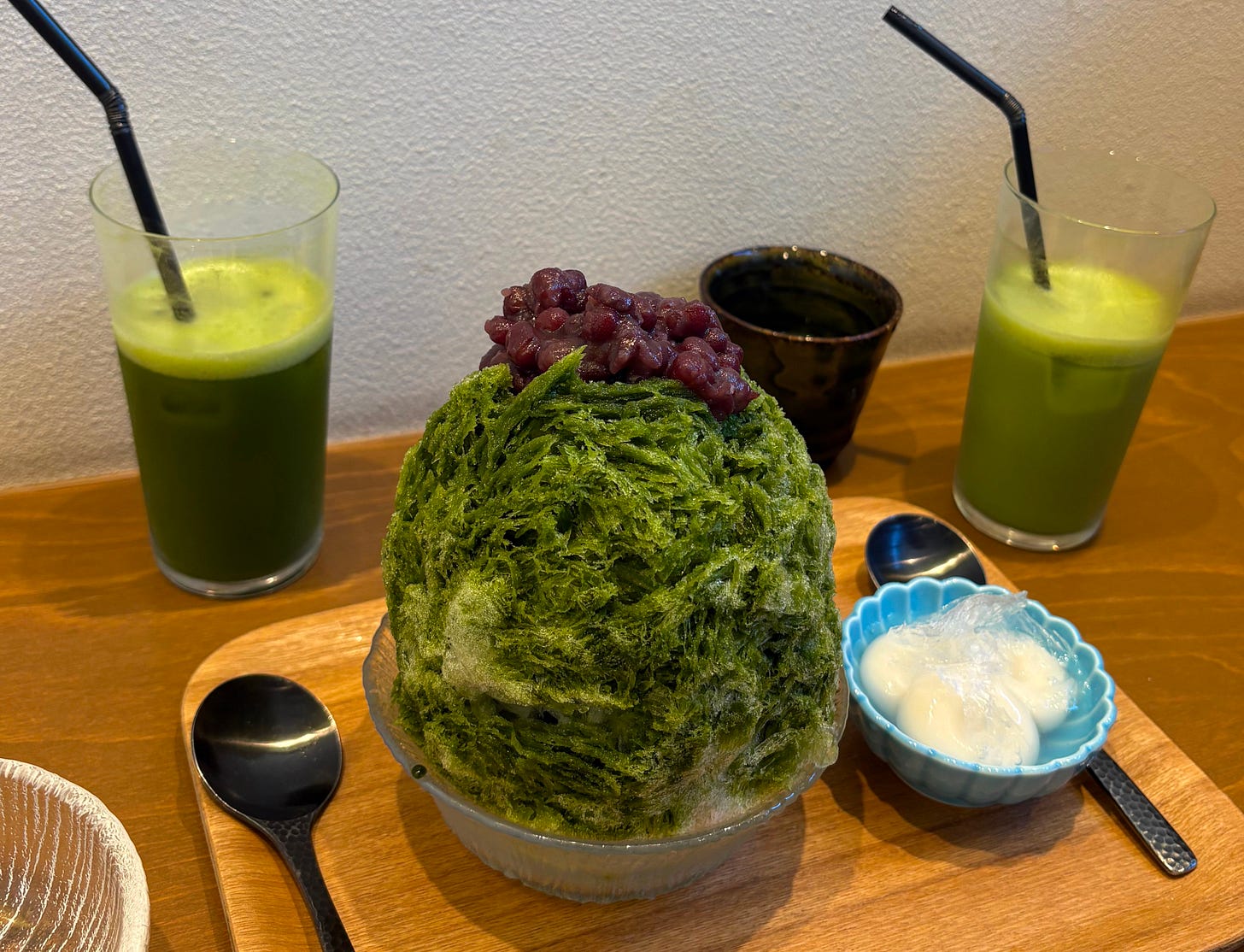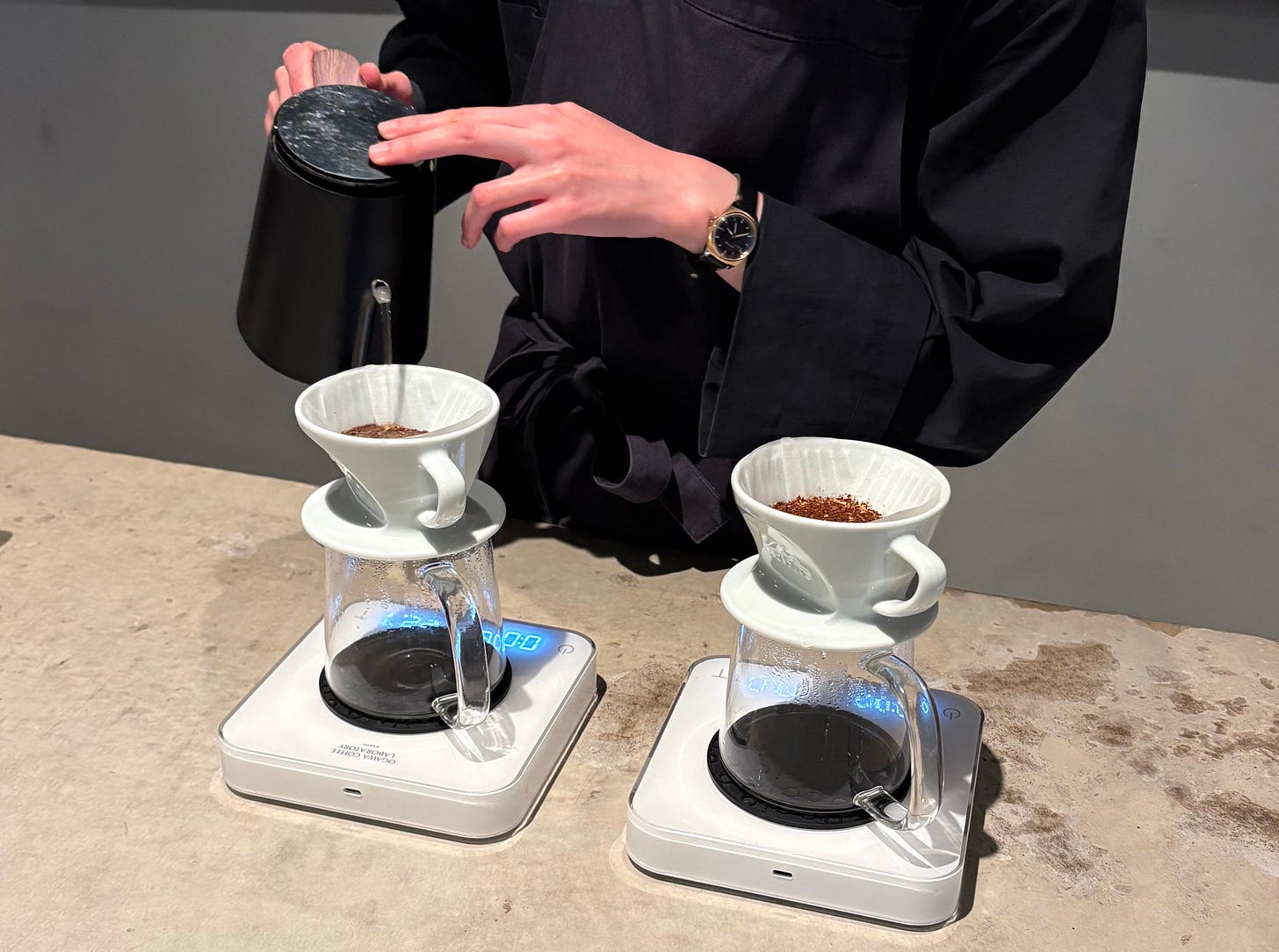Welcome back to my series on Japan. We’re currently covering food. In my last post, I shared the best dishes we ate across 5 categories (from ramen to soba).
I’m following up today with another ‘best in class’ list, a little more snack/light-bite centred. Next week, I’ll share my favourite - ‘best in show’ - restaurants and bars from the trip so you can add to your saved spots for future travels.
Tempura: the crispy sansai tempura from Owan, Ikejiri-Ohashi, Tokyo.
I am not the world’s biggest tempura fan. At its worst, it can be greasy, soggy and lukewarm, a bastardisation of good vegetables. But at its very best - hot, crispy, thinly-battered and lightly-salted - it’s always welcome on my plate. This particular iteration used sansai, and was served as part of an omakase at a restaurant we stumbled upon on one of our first evenings in Tokyo. Sansai is a collective term for various leafy green wild mountain vegetables; they’re often slightly bitter and, like broccoli, they make good tempura because of the surface area to volume ratio (lots of leaves and florets to catch the batter, oil and dipping sauce).
Coming in from a chilly evening, this dish - cooked by an enthusiastic chef-proprietor with whom we communicated exclusively via Google Translate - was a marvel.
Honorable mention to: another sansai tempura at a tiny Izakaya called Robata in Furano, Hokkaido. More on this place next week.
Onigiri: the smoked mackerel and bonito rice-balls at the The Smoke Shop, Sapporo station.
My excuse for the lack of photo documentation here is that this onigiri was bought and consumed during travel, where the primary focuses were: racing to catch an ever-timely intercity train; managing 3 large suitcases, maintaining silence; trying to avoid looking as little like hapless gaijin as possible. But boy was this onigiri good.
If you know me, you’ll know how big a fan I am of these ostensibly simple but highly comforting snacks. Yes, they’re just rice around a filling (usually fish-based, though non-animal variants like kelp or pickled plum are available), but as with any dish that’s pared down to very few component parts, the quality of those components makes a big difference. Most konbini onigiri will do you just fine (7/11 tuna mayo being my favourite), but if you happen to go through Sapporo station, please try to find a bento stand called The Smoke Shop. It sells a variety of cured and smoked goods, and a couple of onigiri variants that were utterly delicious, packed with filling and using perfectly al-dente, well-seasoned rice. We got the smoked mackerel with kewpie mayo and shiso, and the soy bonito.
Here’s a picture of the honorable-mentionable onigiri served with our sansai tempura at Owan (see above). The rice was warm and instead of a central filling it was speckled with shiso and edamame throughout. Simple but effective.
Pastry: the cheese tart and apple turnover from Kinotoya Bake, Sapporo
Anyone who hasn’t visited Japan will raise an eyebrow at the idea that Japanese pastries can contend with those in Europe; anyone who’s been will know exactly what I’m talking about. As with most imported crafts (denim being a prime example), Japanese patisserie has been elevated above its continental roots. Hokkaido is a particularly good place to seek pastries because it’s known for its high-quality dairy production. In general, if you see ‘Hokkaido’ before a food product in Japan, it’s a signifier for premium/artisanal. This cheese tart was a great example: it had a rich, creamy, centre, with a crumbly butter casing, never too sweet and never too big. The apple turnover was perfectly flaky, crispy, and chewy, retaining the nuttiness of the wholemeal flour with plenty of tangy apple filling.
Honorable mention to: anything from Tolo Pan in Ikejiri-Ohashi. Seriously, this bakery is one of the best I’ve ever been to, inside or outside of Japan.
Dessert: the honeycomb soft-serve from Sugi Bee Garden, Noboribetsu.
I think the theme for this post is becoming ‘simple but effective’. This dessert, from a small local honey shop amongst the hot springs of Noboribetsu, was ‘just’ a plain soft-serve with honey, but it was so much more. As I mentioned before, Hokkaido is known for its dairy output, and soft-serve ice-cream is probably the apotheosis of this. The creamy but airy Holstein milk base was light, delicate, with a subtle sweetness. There were layers of honey folded around the ice cream. There was a brick of honeycomb, golden and chewy, on top. A customary wafer embedded. I’d go back just to have it again.
Honorable mention to: the kakigori at 千寿茶房 in Adachi, Tokyo. I’m not sure if there’s an anglicised version of the name of this little cafe (Google suggests ‘Sensujabo’), but after a long and hot cooking class, we were grateful for the relief of their cold kakigori (shaved ice with various seasonal toppings). We went for matcha with red beans and buckwheat syrup with a few plain warm mochi on the side, and extra matcha to boot.
Coffee: the pour-over selection at Ogawa Coffee Lab, Shimokitazawa.
I am definitely only an entry-level coffee snob, in that I do like a good filter brew and do own a Chemex, but I’ll always order a flat white (real connoisseurs would eschew espresso and milk) and I can’t bring myself to weigh and temperature-probe everything because…where’s the joy in that?!
That said, I’m certain this coffee shop will please coffee snobs of all gradations. You can select your beans from a global map of 40+ offerings and the baristas had sommelier-level knowledge. It does take about 20 minutes to queue and be served, though, but it’s more like a tasting experience once you’re in.
For matcha, I’m going to be much more ‘basic’ and say that I thoroughly enjoyed the iced latte from The Matcha Tokyo at Shinjuku. Take from that what you will.
Thanks for reading, and see you next week for more Japan food recommendations!












